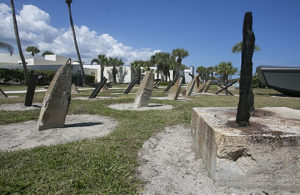World War II Era Beach Obstacles and Hedgehogs from Original NCDU School
 On the grounds of the Museum are the original training obstacles dating from the founding of the joint Army and Navy Amphibious Scout and Raider School in 1942. The training base was established on the Fort Pierce beach where the Museum now stands. These obstacles were discovered in the 1990s by the U.S. Army Corp of Engineers and were donated to our collection.
On the grounds of the Museum are the original training obstacles dating from the founding of the joint Army and Navy Amphibious Scout and Raider School in 1942. The training base was established on the Fort Pierce beach where the Museum now stands. These obstacles were discovered in the 1990s by the U.S. Army Corp of Engineers and were donated to our collection.
At the start of World War II, U.S. war planners realized that challenging the Axis powers would require massive and numerous beach attacks from Africa to Normandy to hundreds of islands in the Pacific. Every one of those beaches was defended by an intricate network of underwater obstacles, booms, mines, chains and barriers known as Belgian Gates and Bruges Barges.
The school that operated on our grounds trained combat divers to locate obstacles, map lines of attack, disarm mines, and demolish natural and man-made beach blockages. Our obstacles were used to give trainees an idea of what they would encounter in France, Italy, Africa and the Pacific. Some were straight angled pillars and some were L-shaped, X-shaped and H-shaped “hedgehogs” that functioned even when knocked over. The obstacles could rip the bottom out of landing craft and often were topped by “teller” mines, flat plate-shaped explosives (“teller” is German for “plate”). Navy combat divers removed thousands of obstacles like these, often under heavy fire, during WWII.
The men who trained using these obstacles here in Ft. Pierce were involved in amphibious assaults from North Africa to Normandy. Please visit the Navy SEAL history section for more information on the history of Navy SEAL predecessor organizations and their operations during World War II.

